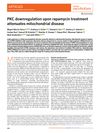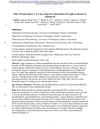Rapamycin
aka - Rapamune
- Sirolimus
Rapamycin, also known as sirolimus, is a macrolide compound discovered in the 1970s from the bacterium Streptomyces hygroscopicus, originally isolated from a soil sample from Easter Island. Initially developed as an antifungal agent, its potent immunosuppressive and antiproliferative properties soon became evident, leading to its FDA approval for preventing organ transplant rejection. Rapamycin specifically inhibits the mechanistic target of rapamycin (mTOR), a critical regulator of cell growth, proliferation, and survival. This inhibition affects various cellular processes and has major implications in aging, cancer, metabolic diseases, and, as recent research suggests, hair loss and regeneration.
The role of rapamycin in alopecia and hair growth is linked to its action on the mTOR pathway, which is involved in the regulation of the hair follicle cycle and generally implicated in aging across most organisms. Preliminary studies suggest that rapamycin might promote hair regrowth in part by transitioning hair follicles from the resting phase (telogen) to the growth phase (anagen). This is significant for conditions like alopecia areata, where hair follicles are prematurely forced into the telogen phase, leading to hair loss. Rapamycin's potential to modulate the hair cycle and promote anagen re-entry opens new avenues for treating various forms of hair loss.
Research into rapamycin's effects on hair loss is still in its early stages but shows promise. For example, a study demonstrated that transdermal dissolvable microneedles loaded with rapamycin effectively promoted hair regrowth in mice. This innovative approach directly delivers rapamycin to the hair follicle niche, inducing anagen phase and hair regrowth. These findings suggest that rapamycin, either alone or in combination with other agents like epigallocatechin gallate, could be a novel strategy for encouraging hair growth. However, the translation of these results from animal models to human applications requires further clinical trials to establish efficacy, optimal dosages, and safety profiles.
Within the community, discussions on rapamycin center around its potential benefits for hair pigmentation and regeneration, referencing effects observed in animal studies. Members share personal experiences and theoretical discussions on using rapamycin for hair loss treatment, indicating a keen interest in its application beyond traditional uses. The community also explores the combination of rapamycin with other treatments like minoxidil and finasteride, pondering the potential synergistic effects on hair regrowth.
In summary, rapamycin is a compound with broad therapeutic potential, extending from its established role in immunosuppression to emerging applications in treating hair loss. Its mechanism, targeting the mTOR pathway, offers a novel approach to promoting hair regrowth and cycling. While initial research is promising, comprehensive clinical trials are needed to fully understand rapamycin's efficacy and safety for treating alopecia.
Research
20 / 650 resultsresearch Mammalian Target of Rapamycin Complex 1 (mTORC1) May Modulate the Timing of Anagen Entry in Mouse Hair Follicles

research PKC Downregulation Upon Rapamycin Treatment Attenuates Mitochondrial Disease
research Effects of Immunosuppressive Peptidyl-Prolyl Cis-Trans Isomerase (PPIase) Inhibitors, Cyclosporin A, FK506, Ascomycin, and Rapamycin, on Hair Growth Initiation in Mice: Immunosuppression Is Not Required for New Hair Growth
research Rapamycin But Not Acarbose Decreases Age-Related Loss of Outer Hair Cells in the Mouse Cochlea
research Efficacy and Safety of Sirolimus for Blue Rubber Bleb Nevus Syndrome: A Prospective Study

research Fibrous Papule of the Face, Similar to Tuberous Sclerosis Complex-Associated Angiofibroma, Shows Activation of the Mammalian Target of Rapamycin Pathway: Evidence for a Novel Therapeutic Strategy?

research Promotion of Hair Regrowth by Transdermal Dissolvable Microneedles Loaded with Rapamycin and Epigallocatechin Gallate Nanoparticles
research Acne Keloidalis Nuchae in Renal Transplant Patients Receiving Tacrolimus and Sirolimus

research Protein Kinase C Is a Key Target for Attenuation of Leigh Syndrome by Rapamycin
research Allogeneic Hair Transplantation with Enhanced Survival by Anti-ICAM-1 Antibody with Short-Term Rapamycin Treatment in Nonhuman Primates
research Lam/Tsc Cell Migration to Uterus in an Experimental Model of Lymphangioleiomyomatosis: Regulation by Anti-Epidermal Growth Factor Receptor Antibody and Rapamycin

research Enhancing Hair Regrowth Using Rapamycin-Primed Mesenchymal Stem Cell-Derived Exosomes

research Low-Dose Rapamycin Microdepots Promote Hair Regrowth via Autophagy Modulation

research A Low Dose of Rapamycin Promotes Hair Cell Differentiation by Enriching SOX2+ Progenitors in Neonatal Mouse Inner Ear Organoids

research Valproic Acid and/or Rapamycin Preconditioning Protects Hair Follicle Stem Cells from Oxygen Glucose Serum Deprivation-Induced Oxidative Injury via Activating Nrf2 Pathway

research Protein Kinase C Downregulation Upon Rapamycin Treatment Attenuates Neuroinflammation and Mitochondrial Disease
research Prevention of Murine Sclerodermatous Chronic Graft-Versus-Host Disease by Rapamycin

research Effect of Immunosuppressive PPIase Inhibitors, Cyclosporin A, FK506, Ascomycin, and Rapamycin on Hair Growth Initiation

research Skin Expression of Mammalian Target of Rapamycin and Forkhead Box Transcription Factor O1, and Serum Insulin-Like Growth Factor-1 in Patients with Acne Vulgaris and Their Relationship with Diet


